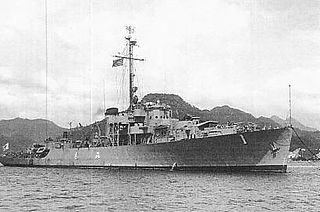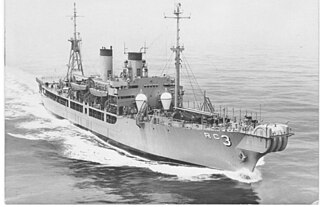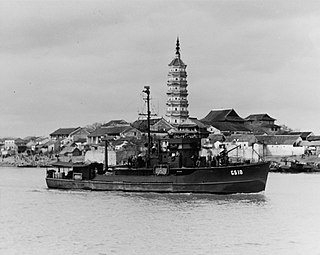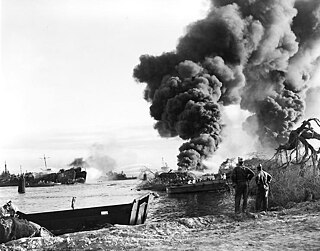
USS Sandusky (PF-54), a Tacoma-class frigate in commission from 1944 to 1945, was the second United States Navy ship of the name and the first to be named for Sandusky, Ohio. She later served in the Soviet Navy as EK-7 and in the Japan Maritime Self-Defense Force as JDS Nire (PF-7), Nire (PF-287) and as YAC-19.

USS Poughkeepsie (PF-26), a Tacoma-class frigate in commission from 1944 to 1945, was the first ship of the United States Navy to be named for Poughkeepsie, New York. She later served in the Soviet Navy as EK-27 and in the Japan Maritime Self-Defense Force as JDS Momi (PF-4), JDS Momi (PF-284), and as YAC-13.

USS Albuquerque (PG-115/PF-7), a Tacoma-class patrol frigate in commission from 1943 to 1945 and from 1950 to 1953, was the first ship of the United States Navy to be named for Albuquerque, New Mexico. She also served in the Soviet Navy as EK-14 and in the Japan Maritime Self-Defense Force as JDS Tochi (PF-16/PF-296) and as YAC-15.

USS Rockford (PF-48), a Tacoma-class frigate in commission from 1944 to 1945, thus far has been the only ship of the United States Navy to be named for Rockford, Illinois. She later served in the Soviet Navy as EK-18 and in the Republic of Korea Navy as ROKS Apnokkang (62).

NOAAS Thomas Jefferson is a National Oceanic and Atmospheric Administration (NOAA) hydrographic survey vessel in service since 2003. The ship was built for the United States Navy as USNS Littlehales (T-AGS-52) serving as one of two new coastal hydrographic survey vessels from 1992 until transfer to NOAA in 2003 when it was named after Founding Father and third U.S. president, Thomas Jefferson.

USCGC Yamacraw (WARC-333) was a United States Coast Guard Cable Repair Ship. The ship was built for the Army Mine Planter Service as U. S. Army Mine Planter Maj. Gen. Arthur Murray (MP-9) delivered December 1942. On 2 January 1945 the ship was acquired by the Navy, converted to an Auxiliary Minelayer and commissioned USS Trapper (ACM-9) on 15 March 1945. Trapper was headed to the Pacific when Japan surrendered. After work in Japanese waters the ship headed for San Francisco arriving there 2 May 1946 for transfer to the Coast Guard.
George Washington Littlehales was an American oceanographer and civil engineer, known for his work with the Hydrographic Office.

USS Cormorant (AMS-122/MSC-122) was a Bluebird-class minesweeper in the United States Navy.

The YMS-1 class of auxiliary motor minesweepers was established with the laying down of YMS-1 on 4 March 1941. Some were later transferred to the United Kingdom as part of the World War II Lend-Lease pact between the two nations. One ship eventually made its way into the Royal Canadian Navy postwar.

USS Aeolus (ARC-3) began service as USS Turandot (AKA-47), an Artemis-class attack cargo ship built by the Walsh-Kaiser Co., Inc. of Providence, Rhode Island. In 1954 she was converted into a cable repair ship to support Project Caesar, the unclassified name for installation of the Sound Surveillance System SOSUS. Aeolus was the first of two ships, the other being USS Thor (ARC-4), to be converted into cable ships. Aeolus performed cable duties for nearly thirty years, from 1955 to 1973 as a commissioned ship and from 1973 until 1985 as the civilian crewed USNS Aeolus (T-ARC-3) of the Military Sealift Command (MSC). The ship was retired in 1985 and sunk as an artificial reef in 1988.

USS Clarence L. Evans (DE-113) was a Cannon-class destroyer escort built for the United States Navy during World War II. She served in the Atlantic Ocean and provided escort service against submarine and air attack for Navy vessels and convoys. She was launched on 22 March 1944 by Dravo Corporation, Wilmington, Delaware, sponsored by Mrs. E. E. Evans; commissioned on 25 June 1944 and reported to the Atlantic Fleet.

USS Reybold (DE-177) was a Cannon-class destroyer escort built for the United States Navy during World War II. She served in the Atlantic Ocean and provided escort service against submarine and air attack for Navy vessels and convoys.
USS Fancy (AM-234) was an Admirable-class minesweeper built for the United States Navy during World War II and in commission from 1944 to 1945. In 1945, she was transferred to the Soviet Union and served in the Soviet Navy after that as T-272 and Vyuga.

USS Sculptor (AK-103) was a Crater-class cargo ship commissioned by the US Navy for service in World War II. Sculptor was named after the constellation Sculptor. She was responsible for delivering troops, goods and equipment to locations in the Asiatic-Pacific Theater.

USS Snatch (ARS-27), well known as Scripps RV Argo after conversion to scientific research, was a Diver-class rescue and salvage ship commissioned by the U.S. Navy during World War II and in service from 11 December 1944 through 23 December 1946. Her task was to come to the aid of stricken vessels. The ship is better known from her scientific research role as the Scripps Institution of Oceanography (SIO) research vessel RV Argo. It is that name, apparently not formally recognized by Navy that maintained title to the vessel, found in the scientific literature and public releases about her wide ranging research voyages.

USS Hunting (E-AG-398) was built as the LSM-1-class landing ship medium LSM-398 at the Charleston Navy Yard and launched in the first week of 1945. After service in the Atlantic as a landing ship the vessel was converted in 1953 to a sonar research vessel for the Naval Research Laboratory. Hunting was unique among Navy research vessels of the time in having a center well through which large towed "fish" could be transported and lowered to operating depths. The work contributed to sonar improvements and understanding ocean acoustics.

USS Catherine Johnson (SP-379), later USS Freight Lighter No. 161, later USS YF-161, later USS YC-660, was a freight lighter in commission in the United States Navy from 1918 to 1930.

USS John Blish was a Patrol Craft Sweeper (PCS) of the PCS-1376-Class, five of which were converted to small hydrographic survey vessels designated AGS and later coastal survey vessels, AGSc, that conducted hydrographic surveys for the United States Navy during and immediately after the Second World War. The small PCS type vessels assigned to the United States Navy Hydrographic Office missions conducted pre invasion surveys, sometimes under fire, with the survey crews erecting signals for survey and later navigation, laying buoys and placing lights.

USS LST-39 was a United States Navy LST-1-class tank landing ship used exclusively in the Asiatic-Pacific Theater during World War II. Like many of her class, she was not named and is properly referred to by her hull designation.
A number of vessels of the United States Navy have borne the name Littlehales, after George W. Littlehales.

















